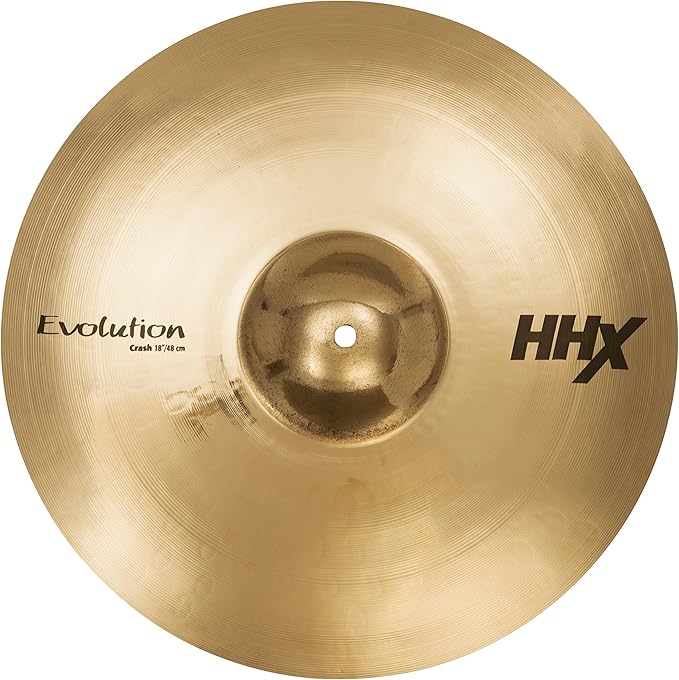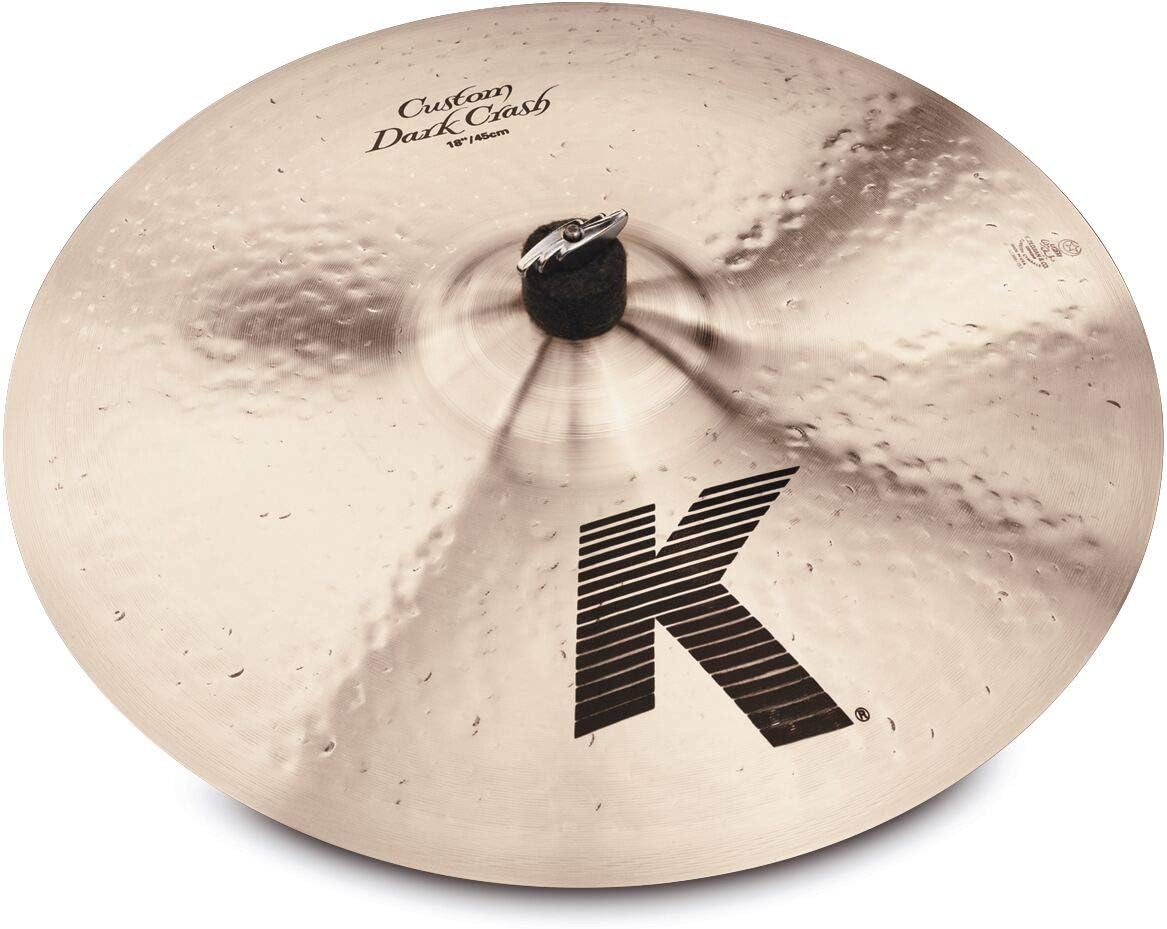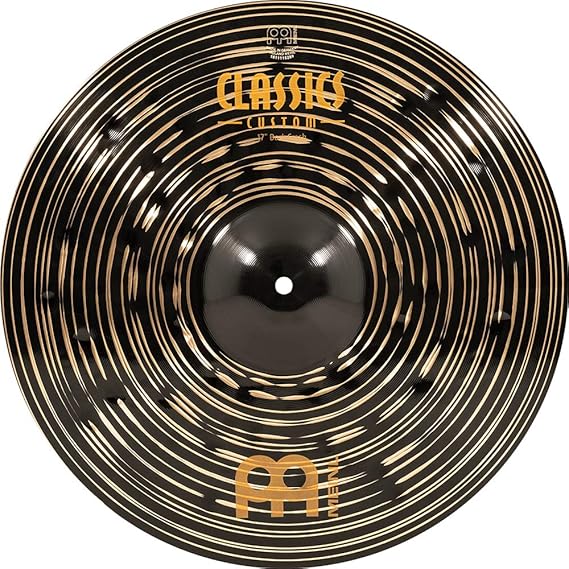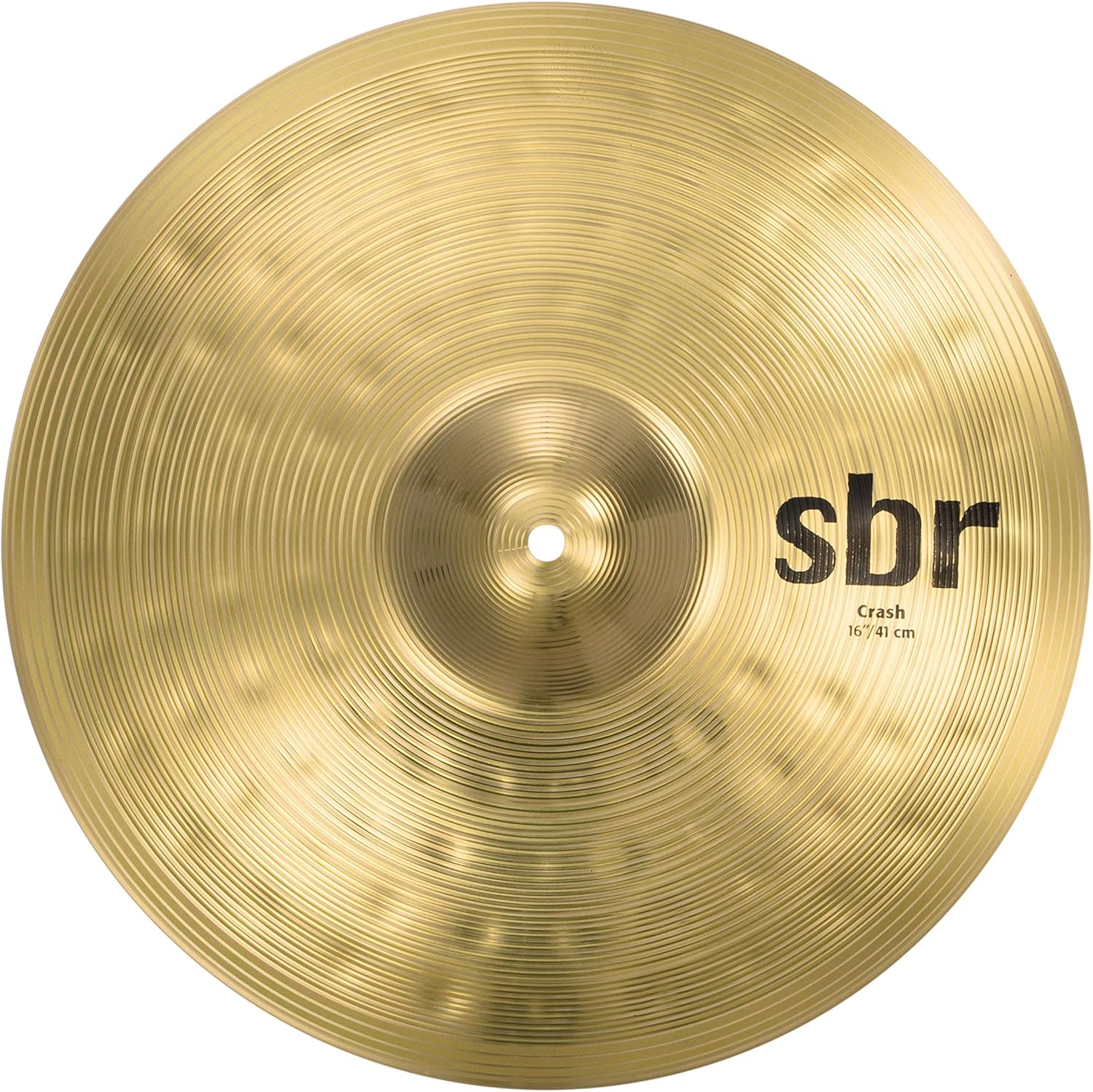Last Updated on July 30, 2021 by Danny
Crash cymbals are an essential tool in any drummer’s drum kit. Their crashy sounds are quite memorable, and any listener will love how they can accentuate the entire section with just a single note. There are many different types of cymbals available, from large brilliant ones to small raw ones. Some cymbals are hand-hammered by artisans, while there are also ones that are mass-produced by machines. Each one has the signature sound that makes it suitable for specific things.
Therefore, it is essential to do the research and find the ones best suited for you. To quicken things up, we have listed the seven best crash cymbals in the market right now. If you are a beginner and are unsure of what to look for in crash cymbals, there is a guide to help you out at the end.
7 Best Crash Cymbals for Rock, Metal, Jazz Music
1. Zildjian A Custom 18″ Crash Cymbal – Best Overall

Zildjian is one of the world’s oldest companies; it was founded way back in the 17th century by Avedis Zildjian. They are one of the most revered cymbal making companies globally; Zildjian means cymbal maker in Turkish. They are known for their hand-hammered cymbals and have many different lines of cymbals, and the A-series is one of their most popular lines.
The Zildjian A Custom 18″ crash cymbals are composed of an 80/20 bronze alloy. This means that it is composed of 80% copper and 20% tin. This specific composition allows it to deliver both high frequencies and warm sound. It is a thin weight cymbal, so it sounds much brighter than other cymbals from Zildjian.
This crash is quite aggressive and rings almost instantaneously. While the sound is bright, the overall sound is well balanced. The brightness allows it to cut through mixes easily. The overall feel is excellent, and the bell is large enough for you to have fun laying with it. The ring of this cymbal is astounding, and the decay is perfect. You can use this for all genres but are typically best suited for fusion, rock, and pop styles.
To sum it up, the A Custom 18″ crash is one of the best, if not the best, cymbals in the market. While it is quite expensive, the quality of the sound is impeccable. The overall durability is also incredible, and many people have had these cymbals last for a decade or more. If you need a crash with absolutely no compromises made, then this would be ideal.
- Sounds Fantastic
- Fast decay with just the right volume
- This is the best A custom cymbal ever made
- Crisp clear tone, goes well with whatever you play
- Poor Shipping
2. Sabian HHX 18″ Evolution – Runner-Up

The founder of Sabian was part of the Zildjian family. However, after some fighting within the family, a member came out and started the Sabian company. While it doesn’t carry the Zildjian name, Sabian cymbals are second to none and are some of the world’s best. This cymbal is made with the same B20 bronze as Zildjian’s premium offerings.
Their HHX Stage 18″ is an excellent dark crash with warm sounds and a penetrating response. The HHX line of Sabian is one of their premium lines, so you can expect it to be built to the highest standards. This crash has a lovely sound and an organic wash, making it ideal for church drummers. The natural release and musicality of these cymbals can beautifully amalgamate with the church choir.
Its medium weight allows it to deliver a solid and aggressive attack while still having a good sustain. This makes it sit perfectly suited for any contemporary electronic music. The Sabian HHX Stage 18″ is a costly crash, but it is as perfect as dark crash cymbals can get. You can be assured that your overall drumming will be elevated with this crash in your kit.
- Aggressive attack
- Suitable for church drumming
- Penetrating response
- Responsive sound with beautiful finish
- Not for hard hitters
3. Zildjian K Custom 18″ Dark Crash Cymbal – Best for the Money

This is another fantastic cymbal from Zildjian. Like the A Custom cymbal, the Zildjian k custom dark crash cymbal is also made from the 80/20 bronze alloy. What sets this apart from the A Custom crash is that it has a much darker sound.
This starts quite loudly but has a sharp and sudden decay. This, in combination with its darker voicing, makes it an excellent choice for jazz and similar genres. Being a full-bodied cymbal, this crash is fantastic for recording and small to mid-sized venues as it can create a great atmosphere. It’s dry and trashy overtones makes it into quite a unique cymbal that can be quickly recognized. However, it cannot cut very well, so it won’t be suitable for a large venue.
These are fully hand-hammered cymbals, and you will be able to notice the finesse and quality improvement when compared to a machine-made crash. It is incredibly responsive to dynamics, thereby letting you hear even your most intricate and subtle techniques. The sound is extremely warm and crisp. There are no shrill overtones like the ones found in A-customs. Overall, the Zildjian k custom dark crash cymbals is an excellent premium crash cymbal for anyone who’s looking for a dark and warm sound.
- Sharp decay
- One of the best dark cymbals
- Extremely responsive
- Warm and clean sounding
- Versatile crash for any music syle
- It doesn’t properly match with the K Custom Dark ride cymbal.
4. Meinl Cymbals Classics Custom Dark Crash Cymbal

The Meinl Classics custom dark crash cymbal is one of the best crashes for metal drummers in the market. This cymbal is loud, harsh, and has an extremely aggressive response. While you can use it for other genres like rock and punk, it is best suited for metal. This 17″ crash can deliver a robust heavy metal sound without any bright overtones. It’s made from a B10 bronze alloy. It comprises 90% copper and 10% tin and can deliver a uniform sound with a sharp cut. The finish of this crash is one of the most beautiful and unique looking. You can see the natural bronze in the lathe marks, which creates a beautiful contrast against the dark finish.
The loud sounds and aggressive attack allow it to cut through any mix and stand apart. If you need a powerful note at the end of a chorus, you cannot go wrong with this. Its dark tone combined with the loud sound allows it to achieve that without much effort. It is made with extra deep hammering that helps enhance overall warmth and dryness. However, all this does come at the cost of versatility. You cannot use it with soft genres like jazz as this cymbal sounds loud no matter how softly you play it.
- Unique and beautiful finish
- Warm and dark sound
- Incredible for metal and rock genres
- Isn’t versatile
5. Sabian B8X 16″ Rock Best for Beginners Under $100

Sabian B8s have been extremely popular over the years as the best 16 crash cymbal for beginners. The B8X is the new version of the B8 and boasts better sound due to improved manufacturing processes. These are known as B8s as they are made from B8 bronze. B8 bronze is composed of 8% tin and 92% copper; this makes them slightly cheaper than the B20 bronze and gives them a brighter tone. You can also notice a slight reddish tint to these crash cymbals when compared to B20 ones.
The 16″ Rock crash of the B8X series is extremely bright and has a powerful attack and a sharp cut. The sound is loud and high pitched, which allows it to be heard through even the most chaotic of mixes. Its ability to cut through mixes is quite crucial as this is meant for rock drummers, and rock performances can quickly subdue darker cymbals. The sound is quite punchy and has excellent projection. These cymbals have pin-point lathing that helps enhance responsiveness and allows you to deliver more complex techniques.
What makes this extremely suitable for beginners is its quality of sound and affordable price. While the sound won’t be good enough for more experienced drummers, a beginner will be able to enjoy its classic sound without any complaints.
- Bright
- Responsive
- Sharp cut
- Ideal for beginners
- Unattractive logo
6. Sabian 16 Inch SBR Crash

Another excellent product from Sabian, the 16″ SBR crash, is a popular entry-level cymbal made from brass. While the brass composition does mean that it won’t sound as rich as a bronze cymbal, it allows the cymbal to be much cheaper. It is also machine-made, combined with the brass composition, allows the SBR crash to be quite affordable. You even get a one year warranty with these crash cymbals.
The 16″ SBR crash is an especially great choice for jazz drummers as it has a much darker tone than other beginner cymbals. The sound is exceptionally crisp and musical, and you can hear its melodic tones integrated with the song. Unlike most beginner crash cymbals, which tend to sound a bit trashy, these feel quite excellent. Unlike most cheap crashes, you can shimmer out quite comfortably in this crash. It can deal with both full heavy strokes and light hits comfortably. However, it’s darker note makes it unsuitable for music styles like metal. While the sound quality isn’t as excellent as the premium Sabian offerings, it is quite incredible for its cost. You get fantastic value for your money with the Sabian 16″ SBR crash, and it’ll be a purchase you surely won’t regret.
- For the price I’d say it’s good, but don’t expect much
- Great for jazz
- Can shimmer
- Not suitable for metal
7. Meinl Cymbals HCS14C 14” HCS Traditional Crash

Meinl has been making excellent cymbals since the 1950s and is well known among amateurs and professionals alike. The HCS14C 14″ crash is an extremely affordable cymbal that is specifically designed for beginners and students. These crash cymbals are manufactured in Meinl’s German factory and are made out of brass alloy.
The 14″ Meinl HCS crash is quite an aggressive crash. It has a very short sustain but is still able to deliver ample volume and depth. The brass composition makes this exceptionally durable, and it should last very long if taken care of. While the HCS sounds a bit thicker and heavier than other budget crashes, the overall sound quality is excellent for a budget crash. For basement practices and jam sessions with your friends, this cymbal would be more than adequate. However, if you are looking for a crash to use for live performances or recording, this crash won’t suit that.
The traditional finish of this cymbal looks quite good and shimmers prettily. The large Meinl stamp and HCS logo nicely complement the overall design. The markings are pretty much the same as the ones found in professional Meinl cymbals. Meinl also provides a two-year limited warranty on these so that you can be worry-free.
Overall, this is an excellent entry-level cymbal that can take quite a beating. You will be able to practice on this for long hours without having any sound or durability issues.
- Cheap
- Durable
- Beautiful finish
- Heavier sound than other crashes
What To Look For In A Crash Cymbal
To find the one best suited for you, there are a few things you need to look at. From the size and thickness to the finish and weight, all these need to be considered. Even the type of music you play is an extremely important deciding factor when it comes to crash cymbals. We have discussed each of these factors in a detailed manner below.
What size crash cymbal should I get?
The size of a cymbal refers to its diameter. Crash cymbals can range from 13″ to even above 20″. That said, the most popular range is between 16″ and 18″. The 18″ can deliver an excellent big, full-bodied sound, while the 16″ can deliver a much sharper and cutting note. Larger cymbals are typically louder and sound deeper, while smaller ones have a shriller note. Most artists typically have two cymbals, one larger one between 17″ and 20″ and a smaller one that’s either 16″ or smaller. This gives them a very wide range of notes.
For genres like ska and jazz, smaller cymbals between 14″ and 16″ would be suitable. Arena rock drummers typically use cymbals of 18″ and 20″. If you are starting and are unsure of what style of music, get either a 16″ or 18″ as you cannot go wrong with them.
Thickness
The thickness of your cymbal affects everything from the stick feel and attack to its decay and sustain.
Thinner cymbals typically are made from B20 bronze and tend to have a swift attack and a short decay. When you strike a thin cymbal, the sound quickly travels from one end to the other and can decay near instantaneously. Thin cymbals are extremely popular among jazz drummers as they are more sensitive and can respond dynamically to stick attack. A soft hit can make them sing, while a harsh shot will give a brash response. You will want to take extra care of these cymbals as they are relatively thin, and improper technique can lead to cracks in just a few short sessions.
Medium cymbals are the most common options and have remained as the standard option for centuries. Their thickness allows them to enjoy the benefits of both thin and thick cymbals. While they have a slightly smaller dynamic range than thin cymbals, they tend to have a more prolonged decay. They can sing way more and are much more durable than the thin ones.
While thick cymbals have only gained popularity since the 1980s, they haven’t decreased since then. Their higher thickness makes them extremely durable and can take extreme beatings. If you strike it with a drumstick tip, they ping and cut almost instantaneously. However, if you drive them properly, they can have a decay that’s quite prolonged. The vast mass of these cymbals allows them to resonate a lot more.
Weight
Cymbals can be classified based on weight into the following categories: extra-heavy, heavy, medium-heavy, medium, medium-thin, thin, and extra-thin. The weight of the cymbal dramatically affects its overall tone and feel of the cymbal.
A heavier cymbal usually has a much higher tessitura (voice) and a greater volume. Heavy cymbals typically have a much slower response but have a prolonged sustain. The frequency range is narrower than in lighter cymbals, and they typically have fewer oven tones. Heavier weight cymbals also tend to have better stick definition. This doesn’t mean that heavier cymbals are better than thinner ones; it just means that they are sonically different.
Selecting from numerous finishes
Nowadays, there are various finishes of cymbals available, this includes raw, brilliant, traditional, sandblasted, patina, and even buffed bronze. Among these, the brilliant and traditional finishes are the most common ones. While you might think that cymbal finishes only affect the aesthetics, they, in fact, do impact the sound.
Brilliant cymbals go through much more processing than their counterparts. They are extremely buffed and polished, and this gives them their signature shine. This process ends up leveling out the various groves that contribute to the cymbal’s sound. This gives these cymbals a much glossier and shimmery sound.
Traditional cymbals, also known as natural cymbals, tend to have a much higher pitch and a more natural tone—the lack of heavy processing results in a more raw finish that yields a more raw sound. Traditional cymbals also tend to have much longer sustains than brilliant ones.
While the finish of a cymbal does not matter as much as the size and shape of a cymbal, the difference in sound between finishes is still significant. So take some time checking out the various finishes and listen carefully to find the one best suited for you.
The selection of Crash also depends on the type of music you play (Jazz, Rock, or Blues)
The style of music is one of the most important deciding factors when it comes to crash cymbals. If you play rock, pop, or metal, you will need a loud and bright crash cymbal that can cut through the huge mix of loud instruments that are usually present in these genres.
If you are into spa, jazz, or blues, you will need a much smoother tone that is low-pitched. These “dark” cymbals can deliver a much more natural and musical sound that can blend within a mix.
Can you use a crash cymbal as a ride?
While you can try to use a crash cymbal as a ride, the sound will be quite off the sound of a ride. A crash will have a more washy sound and won’t have the “ping” sound you expect from a ride. However, using a crash as a ride is a good temporary solution if you are short on cash right now. You could also get a hybrid crash/ride cymbal, which can be used as both a crash and ride effectively.
Conclusion
Well, that rounds up the list of the best crash cymbals you can buy. From budget-friendly options like the Sabian SBR crash and Meinl’s HCS crash to the premium options like Zildjians custom A and K crashes and the Sabian HHX Evolution crash, each of these cymbals provides you with excellent value for your money. The Zildjians custom lines and the Sabian HHX lines are some of the best sounding cymbals globally, and no other crashes even come close to their standards. While the budget options do not sound as good as them, both the SBR and HCS crashes will be ideal for any beginner who wants a crash to whack and learn with.